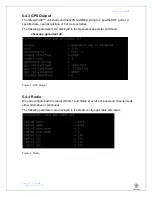
RSU2 User Guide
Savari Inc., Confidential
Copyright © Savari, Inc, 2017
intermediate device (TCID or a Battelle device) is sending periodic Immediate Forward
messages to a StreetWAVE™.
UDP Streaming
4.3.2
The StreetWAVE™ can be configured to receive data from other StreetWAVE™ and stream it
over DSRC. This allows the StreetWAVE™ to function as a repeater. In this setup, one
StreetWAVE™ is configured as the Hub unit and all other StreetWAVE™ that are connected to
it as Spoke units (that are not capable of independently transmitting Store and Repeat,
Immediate Forward etc. and are depending on the Hub to provide this data). The Hub transmits
the data over the air as well as to the Spoke unit typically over an Ethernet link. The Spoke unit,
upon reception of the Hub’s packet, decodes and applies rules that are present in the packet,
signs (if it is present in the packet) and forwards the packet over DSRC. The ability of the
StreetWAVE™ to function in this manner can be used for streaming the packet data (in Savari
proprietary format) from TMCs or back-end servers over the air. This arrangement could be
useful in scenarios where a single StreetWAVE™ may not provide ample coverage for the
geographic area of interest.
4.4
Store and Repeat
StreetWAVE™ supports transmission of Store and Repeat. The Store and Repeat application,
which runs on the StreetWAVE™ unit, transmits on the configured channel over the Radio 1
(default configuration) interface.
Store and Repeat are configured in a data store inside the StreetWAVE™. The data store
supports up to 100 Store and Repeat. The Store and Repeat are stored in the form of Active
message files. Each file contains the transmissions parameters and the actual data of the Store
and Repeat message. Each Store and Repeat message can be scheduled differently. The
active message files follow the USDOT RSE 4.1 Specification.
Active Store and
Repeat Message Configuration
4.4.1
StreetWAVE™ supports the USDOT Active Message Configuration file format for configuring
active Store and Repeat messages.
US DOT Active Message Configuration file format
This format is defined in section
US DOT RSU 4.1 requirements
. Each Store and Repeat
active message should be defined in a separate file.














































